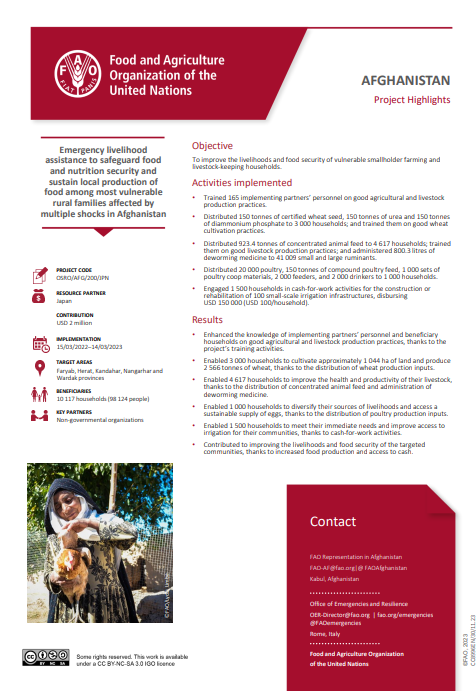Publications
.jpg?sfvrsn=d15e6b0d_1)
FAO Afghanistan contribution to the agricultural sector strategic roadmap, 2026–2028
12/2025
Afghanistan has ranked among the world’s most food-insecure countries for decades. Conflict, climate shocks and chronic underinvestment have left millions trapped in hunger, with rural livelihoods unable to withstand repeated crises.

FAO good practices of climate action in food crisis and fragile contexts
10/2025
Communities in food crisis and fragile contexts are on the frontline of the climate crisis. FAO helps countries prevent, anticipate, absorb, adapt and transform in the face of intensifying climate shocks and stresses.

Afghanistan: Worsening drought – Urgent call for assistance
08/2025
The impacts of the 2025 drought in Afghanistan are threatening the survival of rural households across half the country, compounding one of the world’s largest food crises.

Hunger Hotspots - FAO–WFP early warnings on acute food insecurity: June to October 2025 outlook
06/2025
In the current edition of a regular joint bi-yearly report, the Food and Agriculture Organization of the United Nations (FAO) and the World Food Programme (WFP) warn that acute food insecurity is likely to worsen across 13 countries and territories identified as hotspots, during the outlook period from June to October 2025.

Afghanistan: DIEM – Data in Emergencies Monitoring brief, round 10
05/2025
This Data in Emergencies Monitoring (DIEM-Monitoring) brief shares the results of the tenth-round assessment conducted in February 2025 in Afghanistan.

Special Fund for Emergency and Resilience Activities (SFERA) – Annual report 2024
05/2025
The Special Fund for Emergency and Resilience Activities (SFERA) enables the Food and Agriculture Organization of the United Nations (FAO) to take rapid and effective action in response to food and agricultural threats and emergencies.

Annual report 2024: Norway’s contribution to the Special Fund for Emergency and Resilience Activities
05/2025
The Special Fund for Emergency and Resilience Activities (SFERA) enables the Food and Agriculture Organization of the United Nations (FAO) to respond swiftly and flexibly to food and agricultural emergencies.

Saving lives, time and money: Evidence from anticipatory action - May 2025
05/2025
In the context of an existential funding crisis, soaring levels of humanitarian need and a spiralling number of extreme weather events, each dollar spent must go further.

Identification, Delivery and Empowerment Application (IDEA): An FAO ecosystem of applications to power livelihoods and agricultural assistance in food crisis contexts
03/2025
The Identification, Delivery and Empowerment Application (IDEA) is a digital ecosystem of applications developed by the Food and Agriculture Organization of the United Nations (FAO) to ensure the protection and secure management of beneficiary data, and delivery and tracking of assistance.

Sweden’s contribution to FAO’s emergencies operations, March 2025
03/2025
Sweden has reinforced its commitment to global food security with a total contribution of SEK 73 million (USD 7.23 million) to FAO’s emergencies operations in 2025.

Afghanistan: DIEM – Data in Emergencies Monitoring brief, round 9
03/2025
This Data in Emergencies Monitoring (DIEM-Monitoring) brief shares the results of the ninth-round assessment conducted in September 2024 in Afghanistan.

Afghanistan: Assessment on flood damage
12/2024
Since March 2024, Afghanistan has experienced heavy rains. Major flood damage has been reported in several provinces, with extensive and severe impacts.

Contribution from the Government of Sweden to FAO: Annual report 2023
09/2024
In 2023, the Government of Sweden, through the Swedish International Development Cooperation Agency (Sida), contributed SEK 120 million (USD 13.08 million) to the Food and Agriculture Organization of the United Nations (FAO).

Afghanistan: Project Highlights – OSRO/AFG/210/JCA
08/2024
The Government of Japan contributed USD 12 843 911 to improve the livelihoods and food security of 81 400 farming, livestock-keeping and landless households (695 463 people) in Afghanistan.

Türkiye: Project Highlights – OSRO/TUR/007/JPN
07/2024
The Government of the Japan contributed USD 475 000 to improve the livelihoods and social recognition of Ukrainian and Afghan refugees in Türkiye by providing them and their host community members with employment and livelihood opportunities.

Afghanistan: Project Highlights – OSRO/AFG/126/JPN
07/2024
The Government of Japan contributed USD 1 897 294 to improve the livelihoods and food security of 6 100 livestock-keeping households (44 417 people) in Afghanistan.

Afghanistan: DIEM – Data in Emergencies Monitoring brief, round 7
01/2024
This Data in Emergencies Monitoring (DIEM-Monitoring) brief shares the results of a seventh-round assessment conducted in September and October 2023 in Afghanistan.

Global: Project Highlights - OSRO/GLO/203/GER
12/2023
FAO's project entitled "Scaling up Early Warning Early Action (EWEA) for agriculture and food security", funded by Germany aimed to strengthen the resilience of vulnerable people in high risk countries, prevent food crises, and reduce humanitarian needs.

Afghanistan: Project Highlights - OSRO/AFG/200/JPN
12/2023
The Government of Japan contributed USD 2 million to improve the livelihoods and food security of 10 117 rural households (98 124 people) in Afghanistan.

Hunger Hotspots: FAO–WFP early warnings on acute food insecurity
10/2023
FAO–WFP early warnings on acute food insecurity: November 2023 to April 2024 outlook
